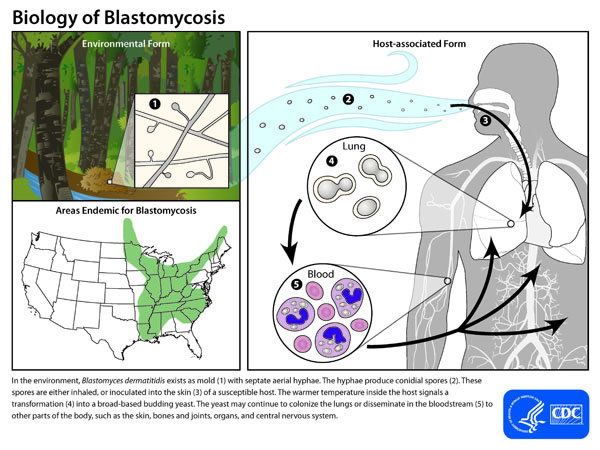Blastomycosis pathophysiology: Difference between revisions
Jump to navigation
Jump to search
Aditya Ganti (talk | contribs) |
Aditya Ganti (talk | contribs) |
||
| Line 17: | Line 17: | ||
*Which eventually leads to the formation of a non-caseating granulomas. | *Which eventually leads to the formation of a non-caseating granulomas. | ||
===Dissemination=== | ===Dissemination=== | ||
*The fungi | *The fungi can disseminate through the blood and lymphatics to other organs, including the skin, bone, genitourinary tract. | ||
[[Image:Blastomycosis-lifecycle.jpg|center|frame|Blastomycosis - life cycle and epidemiology]] | [[Image:Blastomycosis-lifecycle.jpg|center|frame|Blastomycosis - life cycle and epidemiology]] | ||
Revision as of 14:00, 27 February 2017
|
Blastomycosis Microchapters |
|
Diagnosis |
|---|
|
Treatment |
|
Case Studies |
|
Blastomycosis pathophysiology On the Web |
|
American Roentgen Ray Society Images of Blastomycosis pathophysiology |
|
Risk calculators and risk factors for Blastomycosis pathophysiology |
Editor-In-Chief: C. Michael Gibson, M.S., M.D. [1]; Associate Editor(s)-in-Chief: ; Vidit Bhargava, M.B.B.S [2]
Overview
Transmission
- Inhalation of the conidia from its natural soil habitat is considered the most significant route of transmission.
- Other less common route of transmission is by cutaneous inoculation through direct skin injury.
Incubation
- The incubation period varies from 3 weeks to 3 months after exposure.
Pathogensis
- Once inhaled in the lungs, the conidia are mostly destroyed due to their susceptibility to neutrophils, leukocytes and macrophages.
- However, a few conidia escape this protective mechanism and evolve into yeast form, which being double walled structures are more resistant to destruction.
- This conversion releases a glycoprotien BAD-1, which induces cell mediated immunity.
- This results in a pyogranulomatous response at the site of infection (lungs).
- Which eventually leads to the formation of a non-caseating granulomas.
Dissemination
- The fungi can disseminate through the blood and lymphatics to other organs, including the skin, bone, genitourinary tract.
